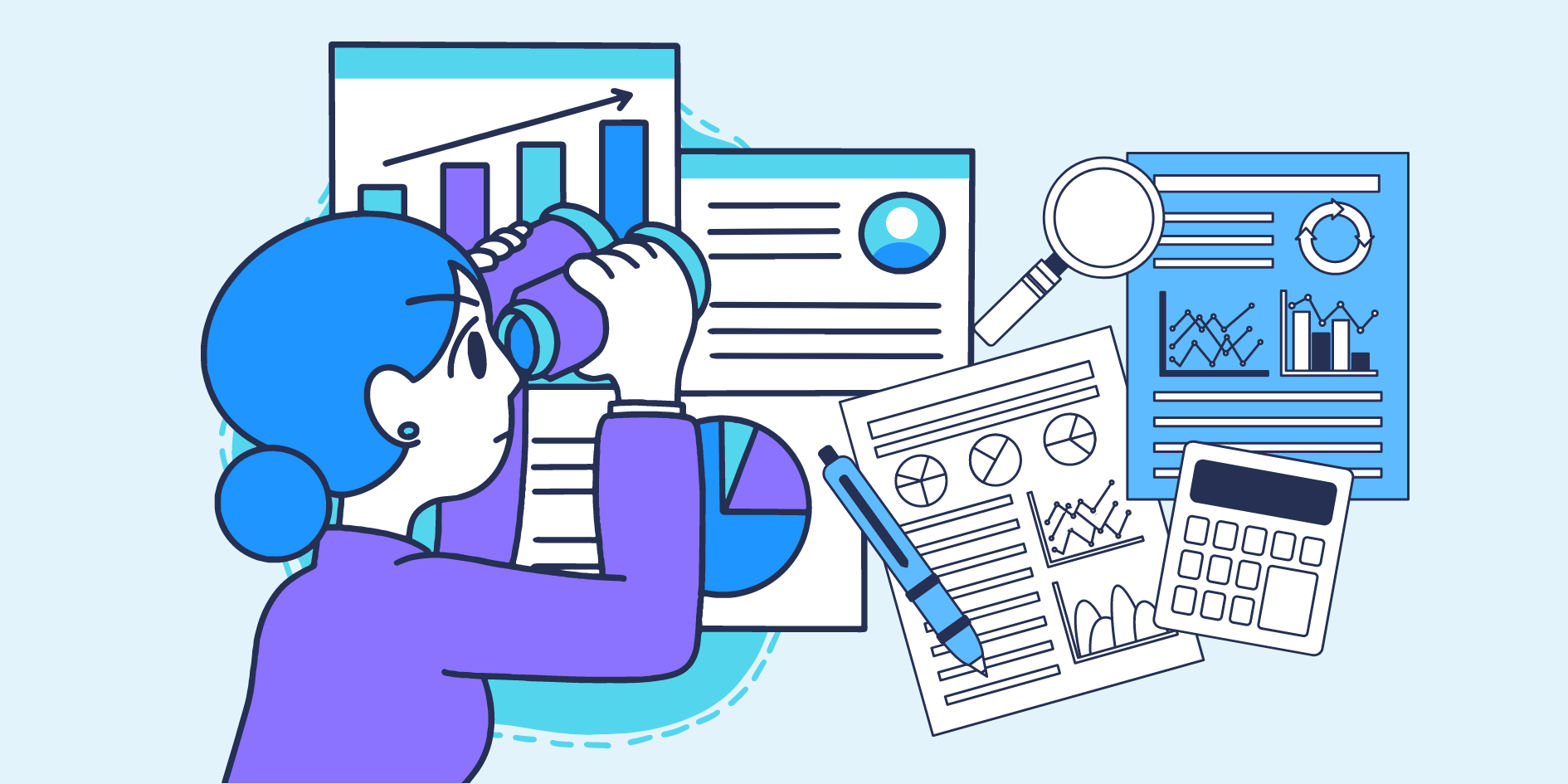Delicately nestled at the intersection of technology, strategy, and human resources lies the position of Workforce Analyst. This job requires one to manage the challenging balance of workforce management and analysis, but the payoff is massive.
What does a workforce analyst do? Simply put, a workforce analyst analyzes data and trends to optimize workforce efficiency and performance.
Workforce Analysts have to be experts in various niche areas. Have you seen those job postings looking for a “data wizard” or “marketing unicorn“? Normally, seeing those postings on LinkedIn or a company’s website elicits an eye roll from us, but we must admit — it might make sense in this case.
This guide will draw a path for aspiring professionals who are set on mastering workforce analytics — a field where every decision is backed by data and strategy. We’ll also explain how to become a Workforce Analyst, the key responsibilities, and (perhaps most importantly) the average salary you can expect.
Boost your team’s efficiency with Hubstaff's productivity tools
What is a Workforce Analyst?
A workforce analyst studies data about a company’s employees to help make decisions about hiring, scheduling, and managing staff more effectively. They can then use this information to understand employee performance, productivity, and staffing needs.
Key responsibilities of a Workforce Analyst
- Data collection and analysis: Gather workforce data and analyze it using software tools to identify trends, patterns, and correlations.
- Workforce planning: Assist in developing short-term and long-term workforce plans aligned with organizational goals, including demand forecasting and scenario planning.”
- Resource allocation: Optimize workforce resources by matching experience levels with workload demands and recommending adjustments to maximize productivity and minimize costs.
- Performance monitoring: Monitor key workforce metrics to track progress against targets, identify areas for improvement, and provide actionable management insights.
- Reporting and communication: Prepare and present reports summarizing workforce analysis findings and recommendations to stakeholders, communicating complex analytical concepts clearly and correctly.
- Project management: Workforce analysts often find themselves undertaking project management responsibilities, ensuring the successful execution of workforce optimization initiatives.
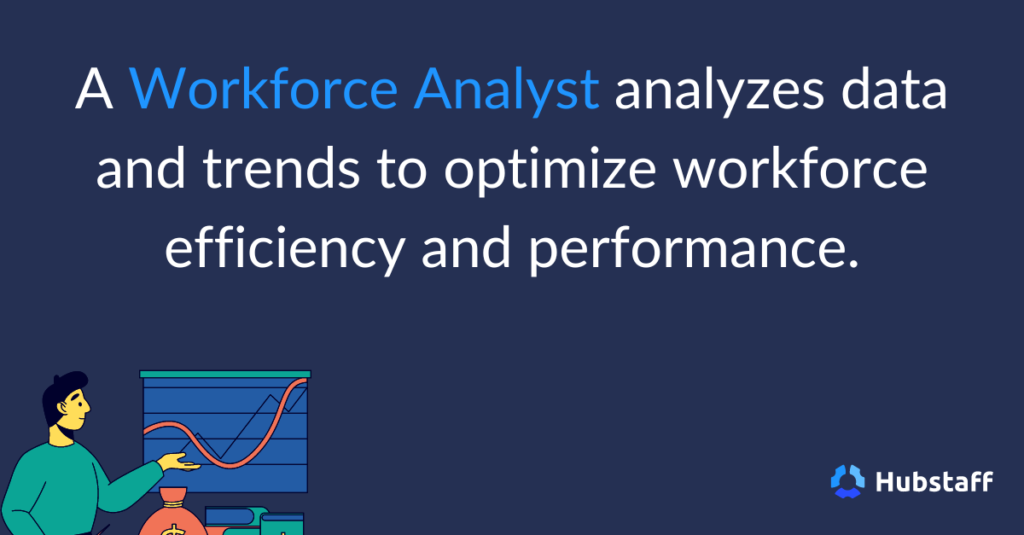
Wrapping this up, workforce analysts contribute to achieving organizational goals and fostering a more effective and productive work environment.
Introduction to workforce analysis
Workforce analysis is like taking a magnifying glass to your workforce to understand how your employees’ skillsets, roles, and overall performance impact company goals.
This level of analysis helps businesses determine if they have the right people, tools, and direction to operate efficiently.
What can workforce analysis do for businesses?
If you jumped on your browser to view information about getting a job as a Workforce Analyst, you’re likely numbers-minded like us. So, we gathered some compelling studies and statistics to explain workforce analysis’s impact:
- Optimizing resources: According to Gartner, 67% of employees say their organization’s HR functions are ineffective at using data. With workforce analytics, you can fully understand the strengths and weaknesses of your workforce. From there, you can then assign tasks more effectively, ensuring that each employee is doing what they do best.
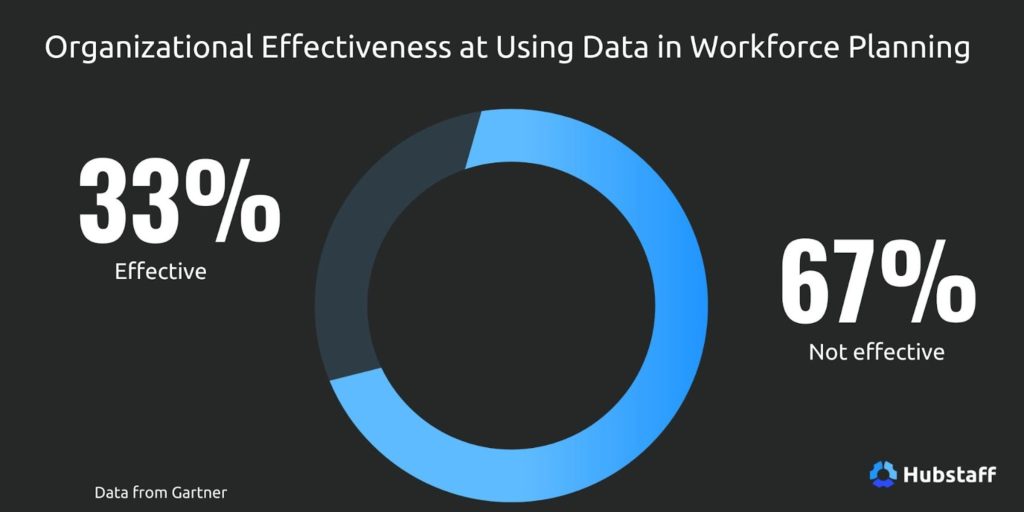
- Identifying skill gaps: You can identify gaps by analyzing your employees’ skills versus the skillsets your team is lacking. Talent optimization should be high on every business’s list of priorities, considering that 87% of talent-optimized companies surpassed or met their goals in the past year.
- Improving productivity: When you have the right people in the right roles, productivity increases. Workforce analysis helps create a connection between employee skills and job requirements, leading to better performance.
- Cost efficiency: With workforce analysis, you can avoid unnecessary hiring or training costs by utilizing existing resources effectively. The average cost of hiring the wrong employee is $17,000, according to research by CareerBuilder.
Overall, workforce analysis is crucial for businesses to ensure they have the right talent to achieve their goals efficiently and effectively.
Becoming a Workforce Analyst — your skillset roadmap
Bringing order to chaos; Workforce Analysts are masters of data, turning numbers into narratives that shape the future of work. However, the journey doesn’t end with data analysis.
Analysts play a pivotal role in verifying the accuracy of information and proceeding with strategic recommendations that align with the organization’s objectives. To excel, you need a specific set of skills and qualifications:
- Data analysis prowess: Your toolbelt should be brimming with expertise in Excel, SQL, and Tableau — or anywhere else that helps you turn raw data into compelling stories. Problem-solving should be your middle name.
- Communication skills: Persuade and present with authority. Communicate your findings in a manner that commands boardroom attention.
- HR and workforce management knowledge: Principles of HR blend with data to find holistic business solutions. A data analyst needs to review data but also find the human element to develop a narrative around it.
- Tech savvy: Experience with cutting-edge workforce management software gives you an edge in the digital landscape.
If it sounds like we’re describing you right now, it’s time to look at how you can become a Workforce Analyst. Let’s dive in.
Workforce Analysts in the workplace
Workforce analytics are vital for growing organizations because they offer insights into employee performance and productivity trends that truly impact your bottom line. With a focus on performance security, you’ll meticulously analyze data to identify potential vulnerabilities and mitigate risks.
By staying up-to-date with the latest industry trends and technological advancements, Workforce Analysts can respond swiftly to changing workforce dynamics, ensuring agility and competitiveness in the market.
By now, you are probably wondering what being a Workforce Analyst actually looks like. Let’s take a deeper dive into Workforce Analysts in the workplace.
Workforce analyst career path
Unless you have some pretty compelling experience, you likely won’t walk out of high school into a workforce analyst position.
Glassdoor has found that most Workforce Analysts have at least two years of experience.

Here’s an example of a career path for someone interested in becoming a workforce analyst:
- Education: First, get a bachelor’s degree in a field like Human Resources, Business Administration, Marketing, Statistics, or Psychology. Consider minoring in data analysis, statistics, or HR management. 57% of Workforce Analysts have a bachelor’s degree or higher.
- Entry-level position: Once you’re out of school, you’ll want to apply for jobs as a Human Resources Assistant or Data Analyst. This will help you gain foundational experience in HR practices and data analysis techniques. Experts say you should stay for a year at your first entry-level job.
- Junior Workforce Analyst: After gaining some experience, transition into a Junior Workforce Analyst role. Here, you’ll assist senior analysts in collecting and analyzing workforce data, identifying trends, and preparing reports.
- Workforce Analyst: You’ve arrived! With several years of experience under your belt, you can move into a full-fledged Workforce Analyst position. On average, you’ll need two to four years of experience to get here.
- Senior Workforce Analyst/Lead Analyst: Your career doesn’t stop at Workforce Analyst. With some experience, you could also progress to a Senior or Lead Analyst role. Here, you’ll take on additional responsibilities such as mentoring junior analysts, leading complex projects, and playing a pivotal role in shaping workforce strategy at the organizational level.
Of course, career paths vary based on individual goals, interests, and opportunities. Networking, gaining diverse experiences, and staying adaptable are essential for success in this field.
How do you level up as a Workforce Analyst?
Our biggest tip is to stay updated on the latest trends and technologies in workforce analysis. Consider pursuing advanced certifications such as the SHRM Certified Professional (SHRM-CP), Professional in Human Resources (PHR), or Certified Analytics Professional (CAP) to enhance your credentials and credibility in the field.
Another key skill you can work on is mastering workforce management technology.
The role of technology in workforce analysis
Technology plays a pivotal role in modern workforce analysis, and software can revolutionize how organizations manage their teams and optimize productivity.
As workforce analytics has grown, so have the tools to help you succeed. Let’s take a few seconds to examine some workforce management tools. First up, a familiar name.
- Hubstaff: Hubstaff is an all-in-one workforce management tool known for its user-friendly interface and comprehensive features. It simplifies employee time tracking and provides valuable productivity insights.
- Additionally, the Insights add-on helps managers effectively manage their teams and combat burnout by offering detailed productivity metrics, performance trends, and industry benchmarks.
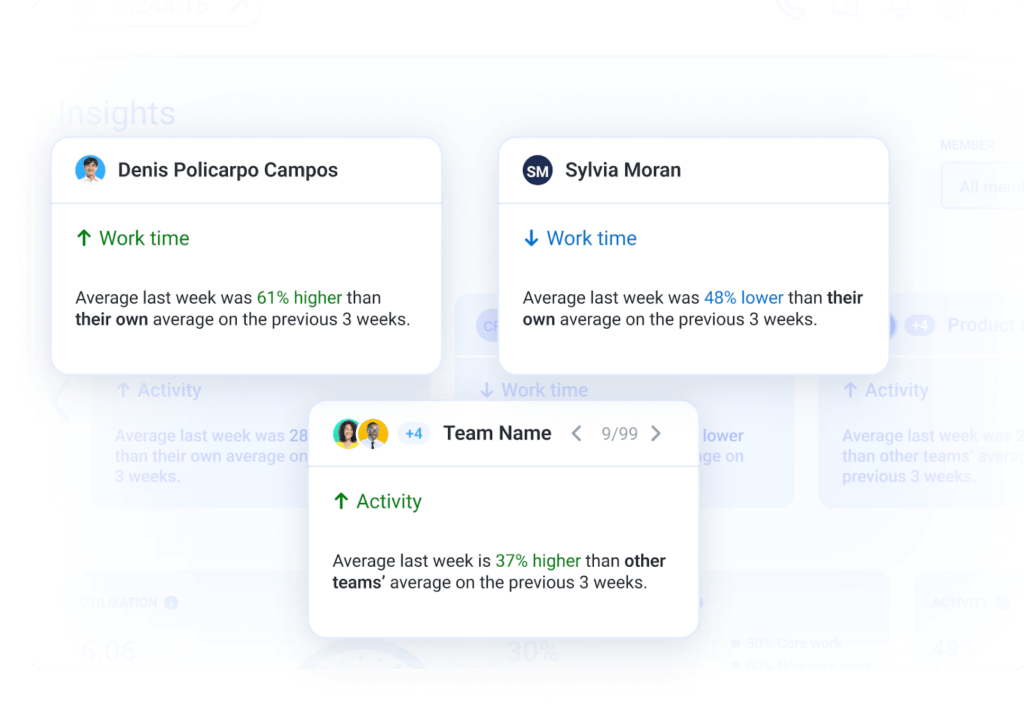
- ADP Workforce Now: An all-in-one HR solution that helps businesses manage payroll, benefits, time and attendance, and other HR functions, all while providing comprehensive data for workforce analysis.
- BambooHR: HR software that includes features for applicant tracking, onboarding, performance management, reporting, and other valuable data for workforce analysis.
- Oracle HCM Cloud: A cloud-based HR management system that offers features for talent management, workforce planning, and analytics for better insights into workforce performance and productivity.
By embracing these software solutions, Workforce Analysts can gain valuable insights, improve productivity, and stay ahead in today’s competitive job market.
Workforce analyst salary insights
Now, let’s talk about the important stuff: money. After all, you’re not doing this job out of the goodness of your heart.
We did some research to find the average salary for a Workforce Analyst. According to Glassdoor, Workforce Analysts in the United States make an average of $61,289 annually. The most likely range for a Workforce Analyst salary is between $49k and $77k.

Wondering where you would make the most money as a Workforce Analyst? Luckily, our friends at Zippia made this custom map of Workforce Analyst salaries throughout the US.
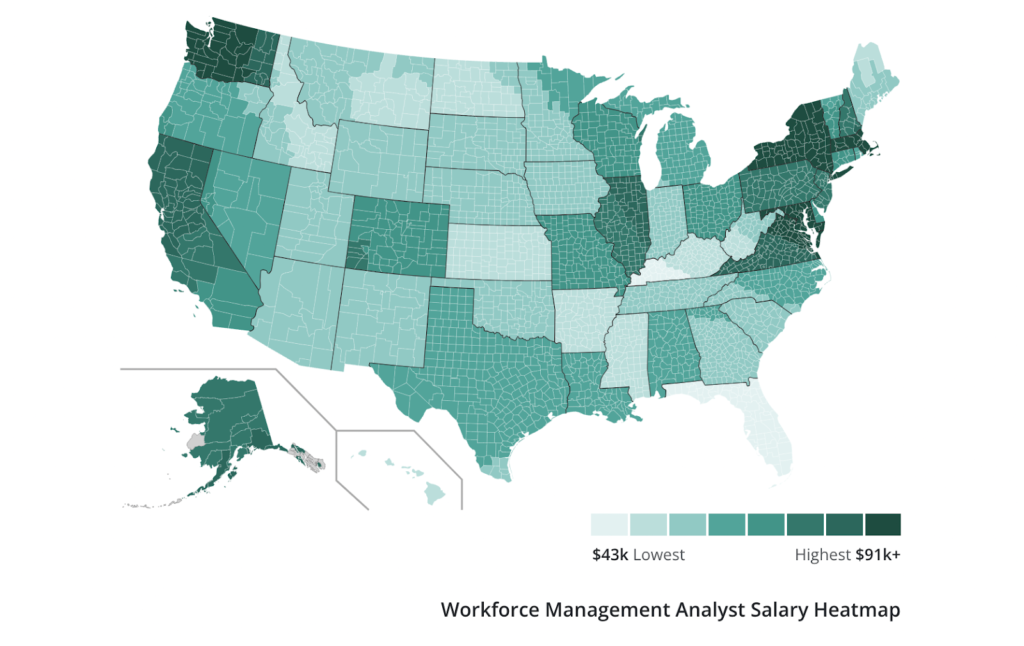
Salaries, as we all know, will vary from industry to industry and be impacted by where you live and the level of experience you bring to the table.
Ready to start your Workforce Analyst career?
Are you ready to transform your career with data-driven decisions that propel business growth? It’s time to update that resume and step into the future of workforce analytics. Become the Workforce Analyst that companies vie for and deliver strategies that drive success.
Have any experience applying for or working in workforce analytics roles? Share your experiences in the comments.
Most popular
The Fundamentals of Employee Goal Setting
Employee goal setting is crucial for reaching broader business goals, but a lot of us struggle to know where to start. American...
Data-Driven Productivity with Hubstaff Insights: Webinar Recap
In our recent webinar, the product team provided a deep overview of the Hubstaff Insights add-on, a powerful productivity measurem...
The Critical Role of Employee Monitoring and Workplace Security
Why do we need employee monitoring and workplace security? Companies had to adapt fast when the world shifted to remote work...
15 Ways to Use AI in the Workforce
Whether through AI-powered project management, strategic planning, or simply automating simple admin work, we’ve seen a dramatic...
